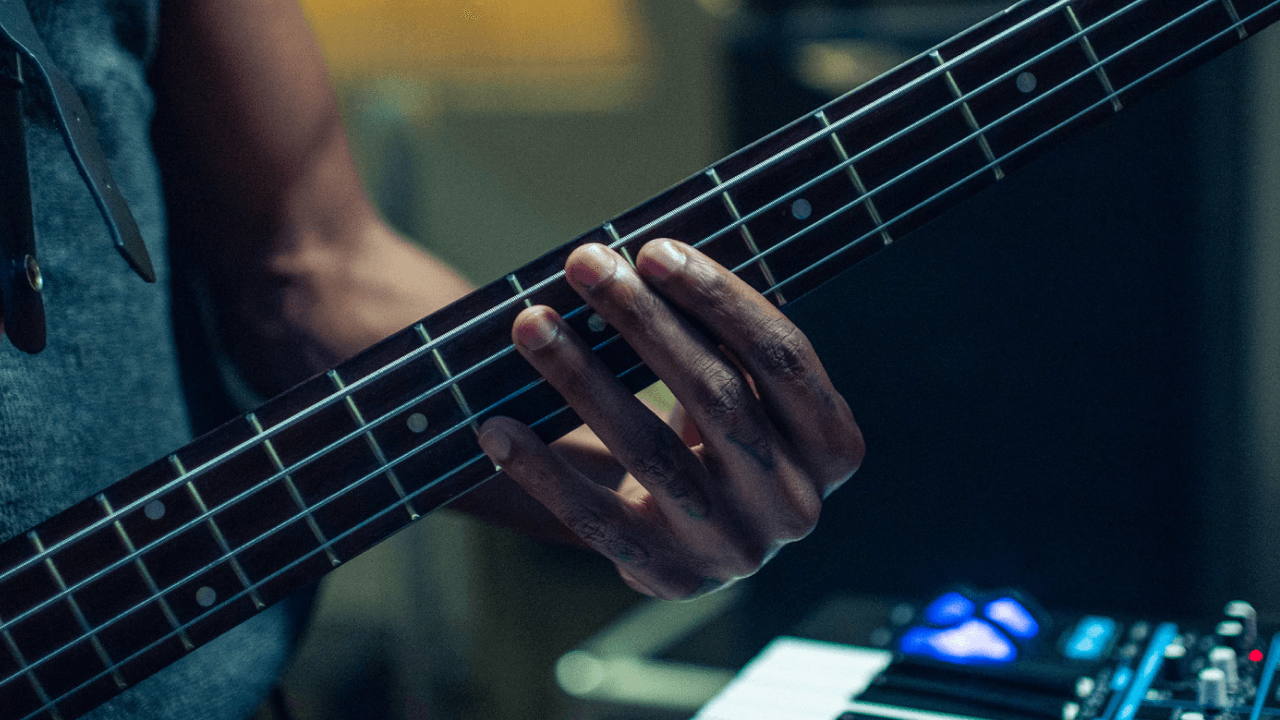In music production, a reference track serves as a benchmark. It guides you towards achieving a sound that resonates with your artistic vision while maintaining industry standards.
This blog post will explore what a reference track is, its pivotal role in music production, and how you can use it effectively to enhance your tracks. So get ready to take some notes!
What is a reference track, and why is it relevant?
A reference track is a professionally produced song (by someone else) that serves as a model for the desired outcome of your own productions. Reference tracks guide decisions throughout the music production process, leading you towards higher quality in your music.
They allow you to compare your work with other producers in terms of arrangement, mix, or overall vibe, and ensure your music meets professional standards and incorporates elements you admire in other artists.
This process can help you find your sound as a producer by allowing you to draw inspiration from the characteristics that make other artists’ music special. When you have a starting point that’s grounded in the context of existing musical ideas and techniques, you’re free from the pressure of creating from a blank canvas.
How to use reference tracks: some practical tips
As you know, reference tracks are invaluable tools in the music production process, offering guidance and inspiration. Next, we’ll explore how you can use them effectively in different stages of the creative process.
During the arrangement phase
Using a reference track during the arrangement phase can significantly enhance your song’s structure and flow. Start by selecting a track with an arrangement you admire that aligns with your vision. Import it into your DAW and break it down into sections—intro, verse, chorus, etc. Then, create a map based on this analysis and use it as a flexible guide to structure your own song.
As you build your track, look for opportunities to incorporate unique elements that reflect your artistic identity. Continuously compare your work to the reference, making adjustments to ensure your arrangement is both effective and engaging.
For chord progressions and melodies
Reference tracks can also be a rich source of inspiration for crafting chord progressions and melodies. By studying successful songs, you can learn from their structure, harmony, and melodic content without merely replicating them. Next are some ways to approach this creatively.
Adapting chord progressions
Start by choosing a reference track with a compelling chord progression that resonates with you. Recreate the progression in your DAW, but don’t stop there. Experiment with variations—alter the rhythm, use chord inversions, or add extensions (7th, 9th, 11th, 13th) to bring new life to the progression.
Consider blending elements from different songs. For example, you might combine one progression's rhythmic pattern with another's harmonic structure to create something uniquely yours.
Changing the key of the progression can also provide a fresh perspective. Modulation, or shifting between keys within the same piece, adds emotional depth and complexity to your track.
Innovating melody lines
To craft original melodies, study the contour and rhythm of the melody in your reference track. Whether it moves in steps, leaps, or combines both, use this as a template to create something new with different notes and rhythms.
You can also take a short motif from the reference and develop it with variations, inversion, or retrograde techniques. Pay attention to how the melody interacts with the chord progression and consider the phrasing and dynamics to give your melody emotional depth and impact.
For sound design and musical ideas
Reference tracks can be a powerful tool for shaping your sound design and coming up with new ideas. By closely studying the instrumentation, timbre, dynamics, and effects in a reference track, you can draw inspiration and apply similar techniques to your own work, all while maintaining your unique artistic voice.
Instrumentation and timbre
To match or complement the sound of your reference track, start by analyzing its instrumentation and timbre. Identify the instruments and their unique qualities. If you can’t replicate the exact sounds, find ones with similar characteristics, such as a warm synth pad or a bright, plucky guitar.
Consider how you can complement the sounds instead of matching them directly, using contrasting elements to create a balanced mix. Let the reference track guide your instrument choices, blending different elements to achieve a cohesive yet distinct sound.
Dynamics and effects
The dynamics and effects in your reference track play a crucial role in shaping its sound. Analyze how these elements enhance the overall feel of the track by paying attention to how the track transitions between quiet and loud sections, the use of compression, and the application of effects like reverb and delay. When applying similar effects to your own music, focus on maintaining balance by adjusting the wet/dry mix, tailoring the EQ, and ensuring that the effects add depth without overwhelming the mix.
For mixing tracks
Mixing is about balancing individual elements within your track to create a cohesive and polished sound. It involves adjusting volume levels, panning, EQ, and effects to ensure clarity and unity before mastering. Here’s how to use reference tracks effectively in the mixing process:
- Selection: Pick a few well-mixed reference tracks within your genre. These tracks should exemplify the sonic qualities you aim to achieve;
- Importing into a DAW: Load your reference tracks into a separate track in your DAW (Digital Audio Workstation), ensuring they aren’t affected by your mix processing;
- Volume matching: Adjust the reference track's volume to match your mix, usually reducing it by -6dB to account for the louder mastered levels;
- A/B testing: Regularly switch between your mix and the reference, focusing on volume balance, tonal characteristics, and the blend of key elements like vocals and bass;
- Frequency balance: Compare the overall frequency distribution of your mix with the reference and make adjustments to match the low, mid, and high frequencies;
- Dynamic range and compression: Analyze how the reference track uses compression, especially on vocals and key instruments, and apply similar techniques to your mix;
- Stereo imaging: Evaluate the stereo width and panning in the reference track and apply similar techniques to your mix to create a balanced and spacious sound.
For mastering your music
Mastering is the final step in the production process. Here, the mixed track is optimized for distribution, ensuring consistency across playback systems and achieving the desired loudness. Here’s how to use reference tracks in mastering:
- Selection and importing: Choose a well-mastered track that aligns with your desired sound and import it into your mastering session without any additional processing.
- Analysis: Use tools like spectrum analyzers to compare the frequency balance, dynamics, and stereo width between your track and the reference and identify areas needing adjustment.
- Loudness matching: Considering industry standards for your genre, adjust your track’s overall loudness in comparison to the reference without compromising dynamic range.
- Frequency balance adjustments: Make necessary adjustments to the master’s frequency balance to achieve a tonal curve similar to the reference track.
- Dynamics and stereo imaging: Apply compression and limiting carefully to match the reference track’s dynamic range and adjust the stereo width to ensure spatial balance.
- Final A/B testing: Continuously compare your master with the reference, making fine-tuning adjustments to ensure your track holds up in terms of loudness, tonal balance, and spatial imaging.
Moises’ Reference Mastering: A fast, easy way to master using a reference track
Moises’ AI mastering tool simplifies the process of achieving professional-quality sound with its Reference Mode. Perfect for users who want their tracks to match the sound of a specific song without needing deep technical expertise, here’s how to use it effectively:
- Select your reference track: Choose a mastered track that represents the sound you're aiming for in your own music. This track will serve as the benchmark for your master.
- Upload your tracks: In the Moises Desktop or Web App, upload both the track you want to master and the reference track. The AI will analyze the reference to match your track’s sonic qualities, such as loudness and tonal balance.
- Adjust preferences: You can fine-tune settings like the limiter and target loudness (iLUFS) to meet specific standards on platforms such as Spotify or SoundCloud. Customize the bit depth (16-bit, 24-bit, or 32-bit float) depending on your needs.
- Preview and compare: Use the swift toggle feature to easily compare your original track with the mastered version. This helps ensure that your track matches the reference and meets your expectations.
- Export your master: Once satisfied, export your mastered track in your desired format (WAV, FLAC, MP3), with the option to select bit depth and sample rates for studio-quality results.
Moises’ Reference Mastering Mode empowers musicians and producers by providing a straightforward way to polish their tracks, making them sound as professional as their favorite songs. This tool is ideal for creating covers, remixes, or original tracks with a polished, cohesive sound.
Elevate your entire production with reference tracks
Reference tracks are powerful tools that extend far beyond the mastering stage, influencing every step of the music production process. By drawing inspiration from works you admire, you can navigate through the complexities of arrangement, mixing, and mastering, ensuring your music not only stands out but withstands professional scrutiny.
Incorporating reference tracks throughout the production process ensures that your music is not only artistically expressive but meets the technical and creative standards of professional music. Whether you’re refining arrangements, mixing elements, or mastering your final track, a reference track can help you achieve a cohesive, polished, and impactful sound that resonates with listeners.







